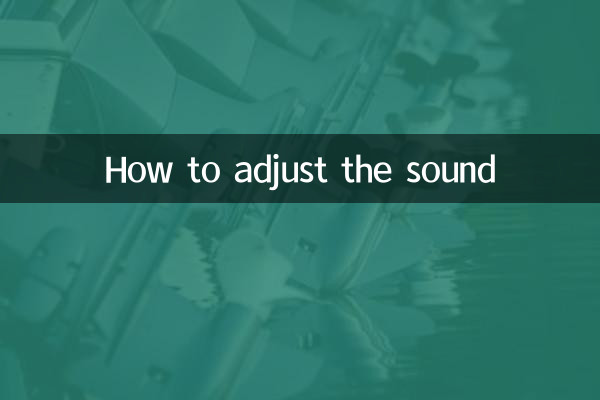Title: How to adjust the sound
Among the hot topics in the past 10 days, audio debugging has become the focus of many music lovers and home theater users. Whether it is home entertainment or professional performances, correct audio tuning can significantly improve the sound quality experience. This article will combine the popular content on the entire network to introduce you in detail how to debug the audio, and provide structured data for reference.
1. Basic steps for audio debugging

Debugging audio requires starting from three aspects: hardware connection, sound effect settings and environmental adaptation. The following are the debugging steps that have been hotly discussed across the Internet in the past 10 days:
| step | Operation content | Popular Tools/Methods |
|---|---|---|
| 1. Hardware connection | Check whether the connection cable between the speaker and the audio source device is secure | HDMI cable, optical fiber audio cable |
| 2. Audio source selection | Choose the best input mode according to the type of audio source | Bluetooth, AUX, USB |
| 3. Basic settings | Adjust volume balance and channel settings | Speaker comes with control panel |
| 4. Sound effect debugging | Adjust the EQ equalizer according to the type of music | Default modes (pop, classical, rock) |
| 5. Environmental adaptation | Adjust speaker position according to room acoustics | Acoustic Measurement APP |
2. Recommended settings for popular EQ equalizers
Equalizer settings are the most concerned part of audio tuning. The following are recommended EQ settings for recent popular music genres:
| music type | Low frequency(Hz) | Intermediate frequency (Hz) | High frequency (Hz) | Popular devices |
|---|---|---|---|---|
| pop music | +3dB | +1dB | +2dB | Bose/Sony |
| classical music | +1dB | +3dB | +2dB | B&W/KEF |
| electronic music | +5dB | 0dB | +1dB | JBL/Beats |
| rock music | +4dB | +2dB | +3dB | Marshall/Logitech |
3. Recent popular audio debugging techniques
1.Room acoustic correction: Use mobile APP (such as Sonarworks) to measure the acoustic characteristics of the room and automatically adjust the sound parameters.
2.Wireless audio delay correction: For the audio delay problem of Bluetooth speakers, it can be adjusted through the "audio synchronization" function in the device settings.
3.Multi-room audio synchronization: Smart home users are concerned about multi-room audio synchronization technology, and Sonos and Bose systems provide the best solutions.
4.Subwoofer debugging: Placing the subwoofer in a corner can enhance the low-frequency effect, but care must be taken to avoid the generation of standing waves.
5.Speech clarity optimization: For film and television dialogue, the 2kHz-4kHz frequency band can be appropriately increased, which is a hot spot in home theater debugging recently.
4. Frequently Asked Questions (recently popular)
| question | solution | Popular index |
|---|---|---|
| There is noise in the speaker | Check the connection cables and avoid running them parallel to the power cables | ★★★★★ |
| Bluetooth connection is unstable | Reduce sources of interference and update device firmware | ★★★★☆ |
| Left and right channels are unbalanced | Use test source calibration to check speaker position | ★★★☆☆ |
| Not enough bass | Adjust subwoofer phase to increase low-frequency gain | ★★★★☆ |
5. Recent suggestions from professional sound engineers
1. Let the speaker "warm up" for 30 minutes before debugging so that the components can reach their optimal working condition.
2. Use professional test tracks (such as "The Sheffield Track Record") for final tuning.
3. Recalibrate the speakers regularly (every 3 months) to adapt to changes in indoor acoustic characteristics caused by seasonal changes.
4. Invest in high-quality audio cables. Monster and AudioQuest brands have been highly praised recently.
5. Consider adding acoustic treatment panels to improve the room’s acoustics.
Through the above methods and techniques, you can achieve more professional sound effects. Remember, debugging is an ongoing process that requires constant adjustments based on specific usage environments and needs. I hope this article helps you have a better audio experience!

check the details

check the details